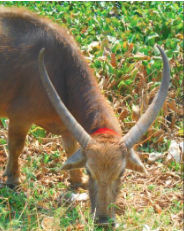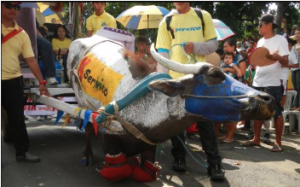Every May in the Philippines is an exciting month for her citizens. The streets of Pulilan in Bulacan Province, San Isidro in Nueva Ecija Province, and Angono in Rizal Province are filled with vibrant-colored decorations, fresh Filipino dishes and desserts, and an audience prepared for the parade which begins the Kneeling Carabao Festival.
The carabaos are painted with intricate designs, pull parade floats that are made by local residents, and are accompanied by their owner and other supporters. Carabaos are known as the Filipino water buffalo that provides meat and dairy and assist farmers to plow their land. The buffalo is even recognized as the national animal of the Philippines: their hard work and powerful symbolism have been celebrated by the Kneeling Carabao Festival for generations. My great-grandfather, Antero Abata Cartas, used carabao on his rice plantation to tend to agriculture in the 1930’s. This prevented him from being directly affected by the Great Depression since he was self-sufficient on the land.
The two main types of carabao that are found worldwide are Swamp and River buffalo; often times Swamp buffalo are found in rice-growing countries in Far East Asia and are known to have a stocky build with short legs but a large belly and neck. River buffalos are located in India or Pakistan for dairy

and labor; they have longer faces with smaller girth and bigger limbs. It is easier to differentiate between male and female River buffalo than Swamp. A particular feature that clearly distinguishes the two are their horns: River buffalo horns grow down and backward then curve up in a spiral, although Swamp buffalo horns extend outward and curve in a semi-circle while remaining on the plane of its forehead (Cockrill 3-7). Josefina Sison, Antero’s eldest daughter, recalls the carabao on her father’s farm: “They were huge! I used to think they were scary but my father let us ride them around and they were so calm. I also remember seeing them plow the fields. I never knew how much strength one animal could have. They were hard-working, too. No matter how hot the weather was like or how tired our carabao was, it always worked hard until its job was done.” The hard work ethic of the carabao enabled farmers to efficiently work on their land by the use of man-made plow carts that are placed on the carabao’s back rather than modern technology.

Being a farmer in the Philippines meant that you were required to make necessary tools in order to tend to your land properly, but when the carabao was introduced during the Metal and Neolithic Age of the Philippines roughly in 2200 BCE everything changed (Amano 1). The massive strength and size of the water buffalo allowed farmers to domesticate carabao and establish a farming practice that is still utilized today. For generations, carabaos have been highly respected amongst the Filipino community. An article from FilipinosAround mentions how the carabao “symbolizes, strength, power, efficiency, perseverance and most of all, hard work.” The author continues, “That is my perception of how a carabao is. To many, it’s more than just a farmer’s helper in the field. The carabao has always given its best for the Filipino farmer. It is the alternative to a tractor, the alternative to a machine-powered plow, never complaining and always at the “mercy” of its master.” Antero used this powerful animal not only as a tool but as a lesson to his family: work hard and remain humble, that will always get the job done.
The carabao is an animal that is so respected throughout the Philippines that there is an annual festival praising its glory. Known for its efforts and eagerness to work, the carabao helped my great-grandfather maintain his farm by relying on his own land and materials instead of manufactured tools, thus leading to him being very successful during the Great Depression. Undersecretary for Operations (Livestock) Jose C. Reaño spoke at a conference validating how important the carabao is to Philippine agriculture to this day, “The carabao is a major contributor in the agricultural industry. It provides us meat and dairy products for consumption and contributes to more sustainable agriculture. Being an agricultural nation, we must give importance to carabao as it is owned by almost 99% of smallholder farmers.” Not only was the carabao a powerful agrarian asset in the Great Depression, but farmers today still profit from their ancestor’s big brown beast.

Works Cited
Caldwell, H. S. The Water Buffalo: a Project. Food and Agriculture Organization of the United Nations, 1977.
Eric. “SYMBOL OF HARDWORK.” FilipinosAround, FilipinosAround, 7 Oct. 2011, filipinosaround.com/2011/10/01/symbol-of-hardwork/.
Noel Amano, Philip J. Piper, Hsiao-chun Hung & PeterBellwood (2013) Introduced Domestic Animals in the Neolithic and Metal Age of the Philippines: Evidence From Nagsabaran, Northern Luzon, The Journal of Island and Coastal Archaeology,8:3, 317-335, DOI: 10.1080/15564894.2013.781084
Padre, Khrizie Evert M. “Importance of the Philippine Carabao Underscored Anew.” Philippine Carabao Center, 8 Dec. 2015, www.pcc.gov.ph/importance-of-the-philippine-carabao-underscored-anew/.